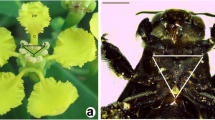Summary
A mature stigma of Petunia hybrida ready for pollination shows 4-6 large shining drops of the exudate along with numerous smaller ones. A developing style and stigma have a columnar tissue that flares at the top. In the stigma there can be distinguished a secretory and a storage zone. In the former, schizogenous cavities are formed which are filled with the exudate. The mode of formation and secretion of the drop has been studied with light and electron microscope. The nature of reserves has been studied histochemically.
The exudation takes place in two stages. In the first stage, the epidermal and papillae cells release out the oily exudate upon rupture of the cuticle. The second phase of exudation begins with anthesis. The exudate from the schizogenous cavities is released between the epidermal cells. There are distinct loci on the stigma surface where more exudate is given out than at other places.
Zusammenfassung
Bei der Durchsicht der einschlägigen Literatur ergab sich, daß die Kenntnisse über die Entwicklungsgeschichte und den Sekretionsmechanismus des Narben-Schleimes äußerst lückenhaft sind, obgleich dieser im Verlauf des Bestäubungs-Vorganges bei vielen Pflanzen eine bedeutende Rolle spielt. Die vorliegende Untersuchung versuchte daher eine detaillierte Einsicht in die Morphologie und Anatomie der Narbe von Petunia hybrida zu geben, da diese Art als Objekt für zahlreiche physiologische Untersuchungen auf dem Gebiet der Befruchtungs-inkompatibilität dient.
Die Blüten von Petunia sind zwittrig, zygomorph und fünfzählig. Sie besitzen fünf epipetale Antheren mit drei verschiedenen Filament-Längen; diese öffnen sich zu verschiedenen Zeitpunkten. Die reife Narbe zeigt zum Zeitpunkt der Bestäubung 4-6 große sowie zahlreiche kleinere, transparente Flüssigkeits-Tropfen.
Der sich entwickelnde Griffel mit der Narbe besteht aus einem säulenartigen Gewebe, das sich an der Spitze verbreitert. Bei der Narbe kann eine Sekretions-und eine Reservematerial-Zone unterschieden werden. In der Sekretionszone werden schizogen Hohlräume gebildet, die sich mit dem Exsudat füllen. Die Bildung und Sekretion der Narbenflüssigkeit wurde licht-und elektronenmikroskopisch untersucht. Mittels histochemischer Methoden wurden die Substanzen der Reservematerial-Zone näher charakterisiert.
Die Freisetzung der Narben-Flüssigkeit findet in zwei Schritten statt: Während der ersten Phase wird das ölige Exsudat von den epidermalen Zellen und den Papillen der Narbe nach Zerreißen der Narben-Cuticula freigesetzt. In der zweiten Phase jedoch tritt das Exsudat aus den schizogenen Hohlräumen durch die Zwischenräume in der Narben-Epidermis aus. Auf der Narben-Oberfläche gibt es Bezirke, welche offensichtlich in reichlicherem Maße Flüssigkeit produzieren als andere Bezirke.
Similar content being viewed by others
Literature
Behrens, W. J.: Untersuchungen über den anatomischen Bau des Griffels und der Narbe einiger Pflanzenarten. Inaug.-Diss. Göttingen 1875.
Esau, K.: Anatomy of seed plants. New York: Wiley & Sons, Inc. 1960.
Freytag, K.: Doppelbrechende und leicht lösliche Lipoide in den Zellwänden der Narbenpapillen verschiedener Blütenpflanzen. Z. Bot. 47, 113–120 (1959).
Gurr, E.: The rational use of dyes in biology. London: L. Hill 1965
Hanf, M.: Vergleichende und entwicklungsgeschichtliche Untersuchungen über Morphologie und Anatomie der Griffel und Griffeläste. Beiheft Bot. Cbl. A 54, 99–141 (1935).
Holden, J. H. W., and D. A. Bond: Studies on the breeding system of the field bean Vicia faba (L.). Heridity 15, 175–192 (1960).
Hunt, K. W.: A study of style and stigma with reference to the nature of carpel. Amer. J. Bot. 24, 288–295 (1937).
Iwanami, Y.: Physiological researches of pollen V. On the inductive tissue and growth of the pollen tube in the style. Bot. Mag. (Tokyo) 66, 189–196 (1959).
Kato, K.: A phenomena in the early stage of pollination in Secale cereale; the stigma reaction. Mem. Coll. Sci., Univ. Kyoto B 20, 203–206 (1953).
—, and K. Watanabe: The stigma reaction II. The presence of the stigma reaction in intraspecific and intergeneric pollination in the Gramineae. Bot. Mag. (Tokyo) 70, 96–101 (1957).
Konar, R. N., and H. F. Linskens: Some observations on the stigmatic exudate in Petunia hybrida. Naturwissenschaften 52, 625 (1965).
—— and H. F. Linskens The physiology and biochemistry of the stigmatic exudate of Petunia hybrida Planta, (Berl.). 71, 372–387 (1966).
Linskens, H. F.: Biochemistry of incompatibility. Genetics Today 3, 629–636 (1964).
— Das Relief der Blattoberfläche. Planta (Berl.) 68, 1–14 (1966).
—, and H. Kroes, Interference microscopy of the pattern of leaf surfaces. Nature (Lond.) 210, 968 (1966).
Lutz, C.: Untersuchungen über reizbare Narben. Z. Bot. 3, 342–347 (1911).
Maheshwari, P.: An introduction to the embryology of angiosperms. New York: McGraw-Hill Book Co. 1950.
Miki-Hirosige, H.: A study of tropism of pollen tubes to the pistils VI. Mem. Coll. Sci., Univ. Kyoto B 29, 75–80 (1962).
Rosenthaler, L., u. F. Kolle: Über die äußerste Schicht der Pflanzen. Ber. dtsch. pharm. Ges. 31, 446–453 (1921).
Stanley, R. G.: Physiology of pollen and pistil. Sci. Progr. 52, 122–132 (1964).
Strasburger, E.: Über fremdartige Bestäubung. J. wiss. Bot. 17, 50–98 (1886).
Vasil, I. K., and M. M. Johri: The style, stigma and pollen tube I. Phytomorphology 14, 352–369 (1964).
Author information
Authors and Affiliations
Additional information
Dedicated to the memory of the late Prof. P. Maheshwari FRS, our teacher (R. N. K.) and friend (H. F. L.) who read through the Ms in April at Paris, a month before his death.
Rights and permissions
About this article
Cite this article
Konar, R.N., Linskens, H.F. The morphology and anatomy of the stigma of Petunia hybrida . Planta 71, 356–371 (1966). https://doi.org/10.1007/BF00396321
Received:
Issue Date:
DOI: https://doi.org/10.1007/BF00396321




